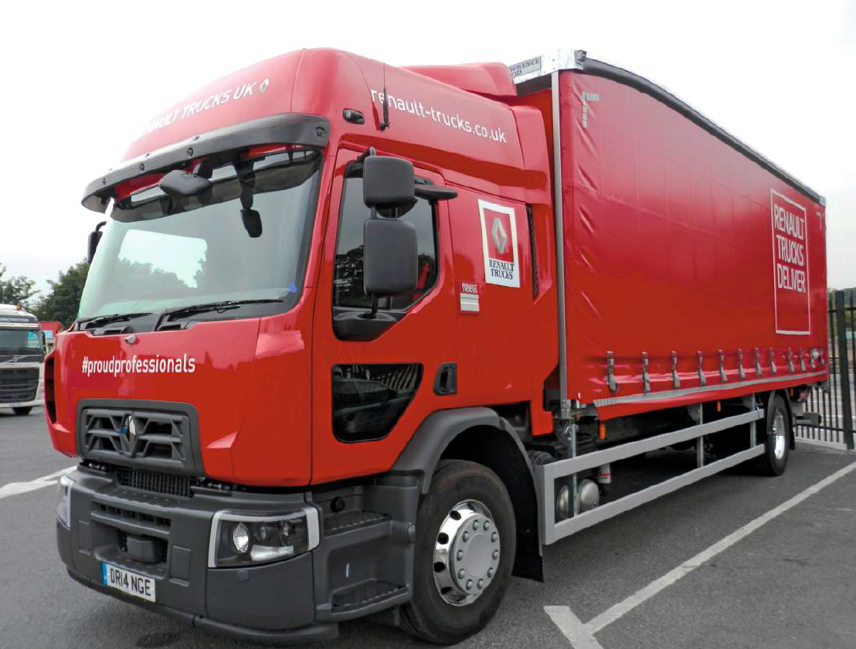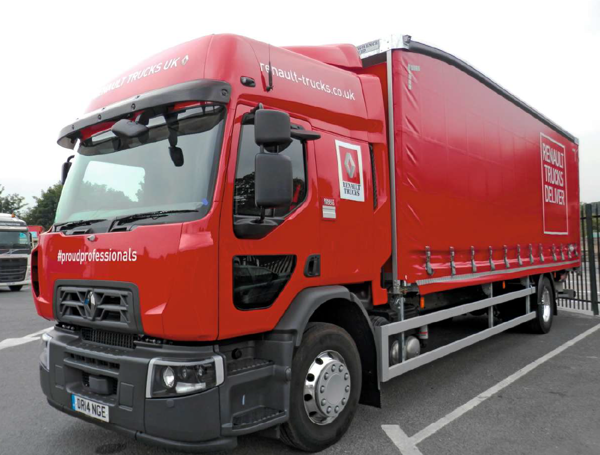Review
Heavyweight distribution is the main aim of the Renault Truck 18-tonne ‘D’ Range
Perhaps one of the unsung heroes in the road transport sector is the heavyweight two-axle rigid market and the Renault ‘D’ Range extends from the lower weights at 7.5-tonne gross vehicle weight (gvw) to the maximum of 18 tonnes.
One of the most significant features on the Renault rigid is the choice of cab widths, with both 2.1 metres and 2.3 metres available. There is also a three-axle version, rated at 26-tonne gvw, with single and the option of a steered rear axle.
Renault uses the Euro VI 7.7-litre engine (DTI 8) which weighs 732kg and has three power ratings starting with 253PS (184kW) and torque at 950Nm, then the middle range 284PS (206kW) and torque at 1050Nm, finally the current highest horsepower of 324PS (235kW) and torque of 1200Nm. We say current as there is a rumour that a 355PS variant for this model may be available next year.
Coupled to the engines is a selection of four gearboxes, including two manual options with a six-speed (ZF6S1000) and nine-speed (ZF9S1110 TO).
Of course in the modern UK distribution sector, the automated gearbox is king and, to satisfy this need, Renault has the 12-speed Optidriver (AT2412) and, finally, for the more specialised transport there is the Allison 3200 six-speed automatic.
Looking for the right wheelbase to accommodate the appropriate body length should not be an issue with the two axle ‘D’ range.
The 2.3-metre wide cab has an impressive 14 wheelbases, ranging from 3.5 metre to 6.8 metre, meaning there’s one virtually every 300mm.
The narrower 2.1 metre isn’t that far behind with 13 wheelbases ranging from 3.25 metre to 6.8 metre.
The 18-tonne chassis sits on 22.5-inch wheels and has either normal leaf springs or the option on the air with the same available on the rear.
Braking starts with retarders and, dependent on your engine choice, there’s a option of five variants from the standard exhaust brake rated at 120kW, the Renault-badged ‘Optibrake’ providing up to 170kW retardation and an electric delivering up to a massive 620kW. As an alternative to electric there’s a hydraulic version at 420kW with the Allison automatic having 400kW.
The service brakes have discs all round, providing a maximum emergency braking deceleration of 7.5m/s compared to the legal 4.5m/s.
The normal array of electronic braking systems comes as standard.
These include automatic emergency braking (ABS), emergency brake assist (EBA) and electronic brake force limitation (EBL).
For the ultimate in braking, there’s always the option of the automatic emergency braking system warning of possible collision followed by braking to bring the vehicle to a complete standstill without the driver’s intervention.
As previously mentioned there are two widths both of which Renault believe are 35% quieter than the previous model.
Under the D8 engine, customers have six cab sizes to choose from starting with the Day cab (available with a flat floor on the 2.3m cab) up to the Global.
Suspension is slightly different on the cabs, with the narrower one having either a four-point or two-point rubber at the front and mechanical on the rear.
The wider cab starts with four point mechanical but also has the option of a four-bag air suspension system.
We were really lucky with our road test model. We happened to pick a recently registered 2.3m 18-tonner fresh from supporting the Renault team at the Monaco Grand Prix so the specification was on the ‘high’ side.
Opening the driver’s door, two steps take you onto the cab floor and onto the air-suspended driver’s seat with side support which is part of the comfort pack option.
This option also has enclosed storage compartments on overhead console, air conditioning, Bluetooth plus USB, 24V pre-equipment in overhead console, smartphone-mounting plate and leather steering wheel.
Directly in front of the driver is the instrument cluster split into three distinct sections. On the left lies circular gauges for fuel, temperature and regeneration status. In the centre is the rev counter with a LCD screen at the bottom for the speed. Finally, on the right is a 4.3-inch LCD screen displaying gear selection, gearbox mode as well as information from the digital techograph.
Perhaps one of the most striking observations is the number of stalks emitting from around the leather steering wheel, there are six – including the infotainment and cruise controls – I am sure that’s a record.
On the left are the engine brake, lights/indicators and cruise control controls, and the right we have the wiper/ washer, gearbox mode selection, and infotainment controls.
Just by the driver’s left hand is the handbrake lever with four-five push buttons for the central locking, heated mirrors and so on.
To the left of the semi-wraparound dash is the CD/MP3 player and two full rows of switches with the rotary controls for the heating and ventilation further to the left.
As an optional fitment the demo truck had the Brigade alert system featuring four cameras around the truck and these are ‘stitched’ together to give a 360° view for safer driving.
Starting the D8 324PS engine and flicking the right stalk to drive gets us on the road around the Derbyshire /Nottinghamshire countryside.
Even after a few miles it becomes apparent this engine enjoys sitting at around 1100rpm and can drop down to 950rpm without any problem.
When braking, the three-stage engine brake lever on the left is in constant use, and as it’s applied the coloured lights around the centre rev counter change to blue between 2000-3000rpm showing the level braking retardation.
It’s also worth mentioning the same happens with the variable green zone lights to help driving in the optimal fuel economy zone.
In-cab noise is minimal and visibility is good and further helped by the optional low level window on the passenger side door just like the old Leyland ‘Road Runner’.
Renault Trucks has moved up a notch in the UK heavy truck and driving the D18 324PS shows the massive steps it has taken in offering UK distribution customers a competitive option to perhaps the more traditional offerings.
Model driven: Renault D Range D18

















